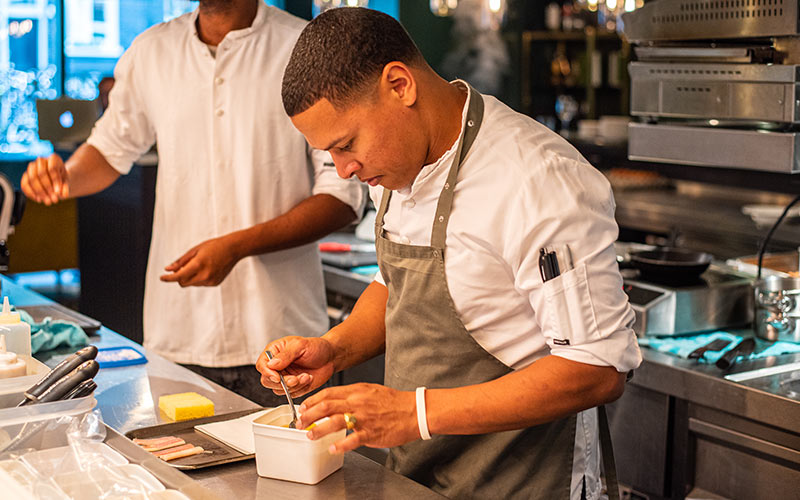
Restaurant staff are one of the most important assets in any restaurant biz. They are the face of your business and their skills – either in the kitchen or interacting with customers – generates revenue for your restaurant.
Anyone in the restaurant industry will know that restaurant staff can make or break a diner’s experience. If guests have a great time with exceptional service, they’re likely to visit again or recommend to friends. However, if their experience is less than perfect you risk them never returning or receiving a bad online review.
Happy and efficient staff means satisfied customers and more revenue for your business. Therefore implementing employee management strategies, such as regular training programmes and setting KPIs, can boost efficiency while also creating a great work environment for your staff.
3 employee management strategies to keep staff and customers happy
We’ve identified 3 key employee management strategies to help you find and retain the best staff for your restaurant.
Free Hospitality Recruitment eGuide
Get expert industry tips for a complete employee management process in this free guide: How to Find, Hire & Retain Your Dream Team.
1. Hire the right staff
The first step in any successful employee management strategy is to hire the right people for your business. Get this step right and the rest of your employee management strategies should (generally) be a walk in the park. However, finding the right staff is often easier said than done.
Recruiting
To kick off your recruitment process you first need to compile all the information that you’ll need to create a job advert. This should include:
- A short description about the role you’re hiring for
- A detailed list of tasks that the new role will be expected to perform
- A list of prior experience and skills that are relevant to the role
- A short description of your business
- Details about the role e.g. full time, part time, casual, salary, benefits
The next step is to advertise your job. You can post an ad in your window, share it on social media, post it on a job portal such as Indeed or Seek or hire a recruitment agency. Don’t forget to ask your staff to refer anyone they think is a good fit for the role as well.
Interviewing
Once you’ve received enough applications and narrowed down your candidates, it’s time to conduct some interviews. When it comes to interviewing prospective employees you need to pick an interview style that reflects your restaurant. If you’re a laid-back pizza joint then your interview style should mirror this. However, if you’re a high-end restaurant your setting and style could be more formal.
You should always ask potential employees to give some examples of their previous experience and how their skills will relate to the role. For example, front of house staff should have a confident, easy-going personality, patience and good communication skills. Whereas your back of house staff need to have strong leadership skills and work well under pressure. No matter the role though, everyone in hospo needs to have a good sense of humour, a can do attitude and enjoy working in a team.
When you’re interviewing, be as honest as possible about your expectations for the role, what it’s like to work at your restaurant and what your team is like. It’s important for potential employees to understand exactly what to expect from the role to avoid high turnover further down the line.

2. Training
Training plays a crucial part in an effective employee management strategy and all new staff should be trained on everything from health and safety to how to use your POS. You should also run regular training sessions to keep all staff up-to-date with the latest regulations and your own expectations.
Employee handbook
An employee handbook is a great tool for effective employee management. Your handbook should be given to new employees on their first day so they know the ins and outs of your restaurant and what’s expected of them. Staff can then keep this at home and refer to it when necessary.
Your employee handbook should include:
- Your mission statement – give a brief description of your business goals, what your restaurant stands for and the type of service you aim to provide.
- Restaurant structure – outline all the different roles and responsibilities within your restaurant so each staff member knows what they’re accountable for and where they can go for help.
- Front of house (FOH) operations – this should cover all tasks your FOH staff will undertake and how they should conduct themselves. Such as table management, order taking, how to greet customers, how to accept payment and how to deal with complaints.
- Back of house (BOH) operations – like your FOH operations, this should include all BOH tasks and responsibilities. Depending on the role, it can include kitchen safety guidelines, cleaning procedures, how to check inventory, how to record wastage and how to place purchase orders.
- Examples – use real life examples to illustrate your points.
- Expectations – this should highlight how you expect your staff to behave, no matter if they’re FOH or BOH.
- Training schedule – ideally you should run a couple of training sessions per year for all staff. This training can act as a refresher, but can also inform staff of any business updates or regulation changes and how to use new equipment you might have invested in.
Providing staff with an employee handbook maintains a level of consistency when it comes to staff training and management. It provides staff (and managers) with a reference point for procedures and behaviour, so everyone is on the same page.
Cross-training
While everyone will be thoroughly trained on their individual roles, it also makes sense to cross-train certain employees so you’re never left short on a busy night or if someone is sick. For example, your bar staff and wait staff can be cross-trained on each other’s roles and responsibilities. Similarly, in the kitchen more than one person should be trained on how to do a stock take or receive a delivery. Cross-training also promotes teamwork and flexibility as your staff get an insight into the complexities of other employees’ roles.
Health, safety and hygiene
Health, safety and hygiene is more important than ever and your staff should be fully trained on the latest health and safety regulations and hygiene practices. Health and safety training should be provided to all new staff members and it should cover everything from cleaning rotas to food safety to legal requirements. It’s also a good idea to hold refresher training sessions for all staff so they are kept up to date with the latest regulations and to make sure they’re always following procedure.

3. Employee management
Once you have hired and trained the best staff for your venue it’s time to implement employee management strategies that will keep them engaged, monitor their performance, boost efficiency and maximise your sales.
Schedule staff efficiently
It’s estimated that 33% of a restaurant’s total outgoings is spent on labour, which is a huge expense for any business. Therefore, efficiently scheduling your staff can save your business thousands of dollars over the year. Inefficient scheduling can affect your profits and customer experience. Roster too many people and you risk wasting money on labour that’s not needed. Schedule too few and your staff may be rushed off their feet, leading to mistakes and a poor customer experience.
There are a number of programmes that can help optimise your employee scheduling and seamlessly integrate with your POS and accounting package. They include:
Deputy: create sales-driven rosters by comparing employees’ skills, availability and costs relative to sales. You can also assign tasks, swap shifts, process leave requests and share updates with staff via SMS, email or Deputy’s News Feed. And if you want to save yourself from any looming payroll errors, simply integrate Deputy with MYOB AccountRight, MYOB Essentials, QuickBooks or Xero.
Tanda: onboard employees, create sales-driven rosters and track attendance with Tanda. You can also monitor staff’s hours and wages in real time, swap shifts, send SMS to employees and be notified when staff’s hours are different to rostered hours.
Set clear KPIs
Setting clear KPIs is a great way to motivate staff by setting achievable goals (and increase revenue in the process). Restaurant owners can use data from their POS to pinpoint areas that need improvement and then create KPIs to boost them.
For example, you notice the average order value (AOV) has decreased this month compared to last. To boost sales and AOV you decide to set a KPI for staff for the coming month. The KPI encourages staff to increase AOV by cross-selling sides whenever a main meal is ordered. At the end of the month, you can pull a report to see who sold the most sides and high performers can then be rewarded.
Setting regular KPIs and targets is a great way to incentivise staff to consistently do their best and hold them accountable. Plus, setting targets based on the insights from your POS system means you can track what initiatives are (or aren’t) working – so you know where to next focus your efforts.
Make sure staff are happy
A happy workforce is often more efficient and their energy is likely to have a positive impact on customer experience. However, if your staff are dissatisfied your turnover rate is likely to be higher and your customer service will be impacted. Therefore it’s important to invest in your employees’ development so they remain happy, motivated and take pride in their job. Consider implementing some of the following strategies to keep your team happy:
- Team building days – take the whole team out for a team building exercise. This doesn’t have to be anything extravagant, a few drinks in a local bar or BBQ at the beach will work.
- Regular meetings – catch up with your team members on a regular basis to check in with how they’re doing, give them feedback and ask if they have any questions or concerns.
- Ask for their opinions – ask your team what works well for them in their day-to-day roles and what needs to be improved. Anything you can do to make their lives easier will have a positive impact on customer experience.
- Set incentives and rewards – when team members hit their goals make sure to reward them for their efforts. This not only shows your appreciation, but also motivates them to do well in the future.
Employee management strategies
Taking the time to set up employee management strategies for your restaurant is the best way to ensure a great work environment for your team. After all, they are the backbone of your business and well trained, happy employees will go above and beyond to give great service. If you can nail your interview process, provide detailed and regular training, set achievable KPIs and motivate your team with rewards you’re sure to minimise your staff turnover rate and build a dependable team who love their jobs.
Free Hospitality Recruitment eGuide
Get expert industry tips for a complete employee management process in this free guide: How to Find, Hire & Retain Your Dream Team.

News you care about. Tips you can use.
Everything your business needs to grow, delivered straight to your inbox.


